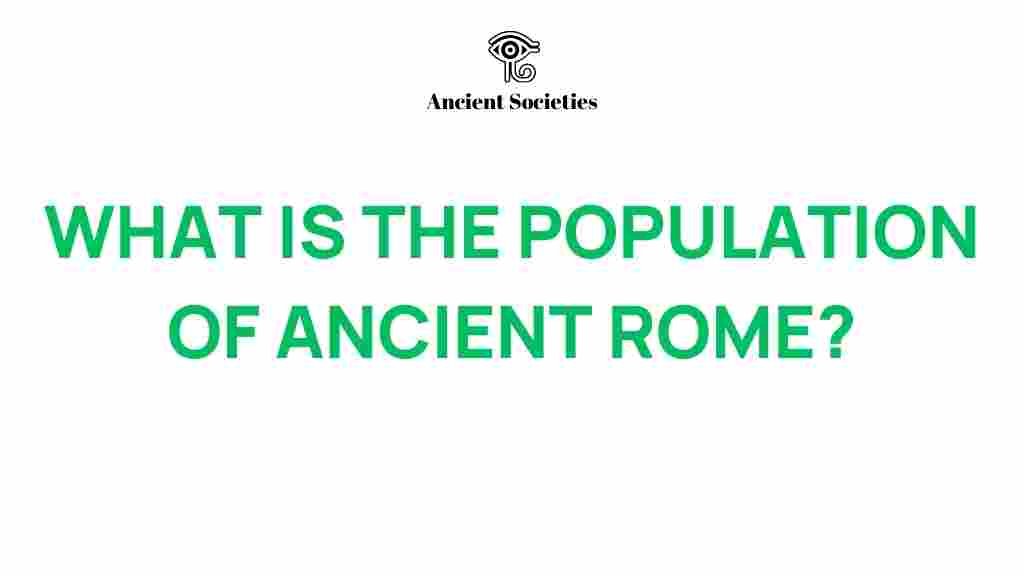Unraveling the Mysteries: What Was the Population of Ancient Rome?
The history of Ancient Rome is a fascinating tapestry of culture, power, and societal evolution that has intrigued historians and archaeologists alike. One of the most compelling aspects of Roman civilization is its population dynamics. Understanding the demographics of Ancient Rome not only sheds light on the empire’s capabilities but also reveals much about its urban life, social structures, and overall history.
The Population Estimates of Ancient Rome
Estimating the population of Ancient Rome is no simple task due to the lack of comprehensive records and the challenges of archaeological interpretation. However, scholars have developed several methodologies to arrive at educated guesses. Here are some key points regarding the population estimates:
- Early Rome: In its early days, around 753 BC, the population was likely small, with estimates ranging from a few thousand inhabitants.
- Republican Rome: By the late Republic (around 100 BC), the population may have reached between 300,000 and 500,000 people.
- Imperial Rome: At its peak during the early 1st century AD, estimates suggest that the population of the city of Rome alone could have been over 1 million, a remarkable feat for the ancient world.
The population of Ancient Rome varied significantly over time due to various factors, including wars, plagues, and economic changes. The fluctuations in population provide a window into the challenges faced by the Roman society and its ability to adapt.
The Factors Influencing Population Growth
Several factors contributed to the growth of the population in Ancient Rome:
- Military Expansion: As the Roman Empire expanded its borders, it absorbed various peoples and cultures, leading to increased population numbers.
- Urbanization: The establishment of cities and infrastructure attracted people from rural areas, promoting urban life and growth.
- Trade and Economy: Economic prosperity through trade routes facilitated the movement of people and resources, further boosting population numbers.
Demographic Composition of Ancient Rome
The demographics of Ancient Rome were diverse, reflecting the vastness of the empire. The population was composed of:
- Citizens: Roman citizens enjoyed certain privileges and rights, including political participation.
- Non-Citizens: Many inhabitants were non-citizens who contributed to the economy and society but lacked the same rights.
- Slaves: A significant portion of the population comprised slaves, who played a vital role in the agricultural and urban economy.
This demographic diversity influenced many aspects of Roman life, including social stratification, cultural exchange, and economic productivity.
Life in Ancient Rome: Urban vs. Rural
The contrast between urban and rural life in Ancient Rome was stark. The city of Rome was a bustling metropolis, while rural areas were primarily agricultural. Here’s how life differed:
- Urban Life:
- Characterized by crowded living conditions, with many people living in insulae (apartment buildings).
- Social interactions were vibrant, with public forums, baths, and entertainment venues like the Colosseum.
- Urban areas had access to amenities such as aqueducts and public latrines, showcasing advanced engineering.
- Rural Life:
- Focused on agriculture, with families often working their own plots of land.
- Social life was more communal, with festivals and gatherings centered around farming cycles.
- Limited access to the luxuries enjoyed in urban areas, leading to a simpler lifestyle.
Archaeological Insights into Population Dynamics
Archaeology has played a crucial role in uncovering the population dynamics of Ancient Rome. Excavations have revealed:
- Burial Sites: Analysis of burial sites provides insights into population health, demographics, and even causes of death.
- Housing Structures: The remains of insulae and villas help researchers understand living conditions and population density.
- Artifacts: Everyday items found in archaeological digs illustrate the daily lives and social structures of different population groups.
These archaeological findings are essential for piecing together a more detailed picture of life in Ancient Rome and its population.
Challenges in Estimating Population
Despite the wealth of information available, several challenges persist in estimating the population of Ancient Rome:
- Inconsistent Records: Ancient records were often incomplete or exaggerated, making it difficult to ascertain accurate figures.
- Urbanization Effects: The rapid growth of cities could lead to temporary spikes in population, complicating long-term estimates.
- Migration Patterns: The movement of people due to military campaigns or trade can skew population data.
These challenges necessitate careful analysis and interpretation of available evidence to arrive at plausible estimates.
Conclusion: The Legacy of Ancient Rome’s Population
The population of Ancient Rome is a critical aspect of its history and legacy. It reflects the complexities of Roman society, from its early beginnings to its peak as a powerful empire. The interplay between urban and rural life, the diverse demographics, and the factors influencing population growth paint a rich picture of Roman civilization.
As we continue to explore the past through archaeology and historical research, the mysteries of Ancient Rome’s population will gradually unravel, providing deeper insights into one of history’s most influential empires. For further reading on the impact of Ancient Rome on modern society, check out this external resource.
To learn more about the fascinating aspects of Roman civilization and its societal structures, feel free to visit our website.
This article is in the category History and created by AncientSocieties Team
